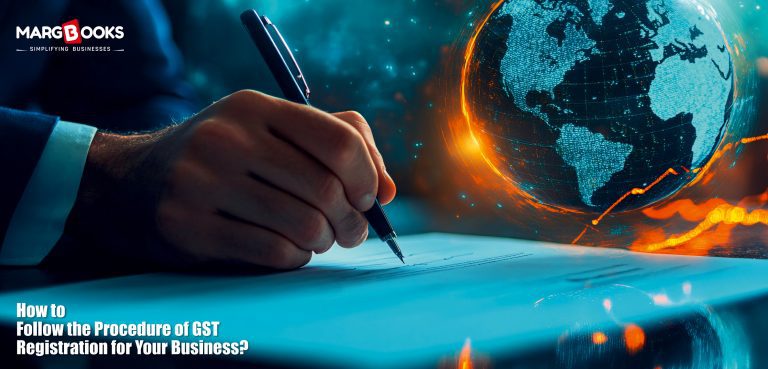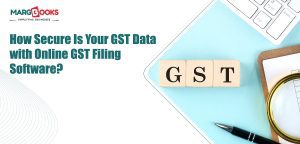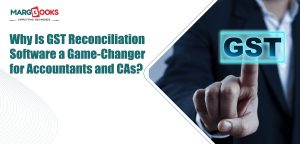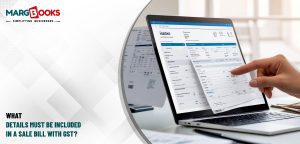Whether you’re launching a small business or scaling up your operations, registering for GST is one of the first crucial steps in establishing a compliant business in India. The procedure of GST registration might seem like a maze at first glance, but once you know the steps and what documents you need, it becomes relatively straightforward.
In this blog, we’ll guide you through each step of the process, highlight the necessary documentation, and show you how tools, GST billing software, and accounting software, MargBooks, can ease your compliance burden.
What is GST, and Why is Registration Necessary?
Goods and Services Tax (GST) is a unified indirect tax that replaced multiple taxes such as VAT, service tax, and excise duty in India. If your business crosses the annual turnover threshold (₹40 lakhs for goods and ₹20 lakhs for services in most states), GST registration becomes mandatory.
Benefits of GST Registration:
- Legal recognition as a supplier
- Ability to collect taxes from customers
- Input tax credit on purchases
- Simplified taxation and reduced cascading effect
Who Needs to Register for GST?
You need to follow the procedure of GST registration if:
- Your business exceeds the turnover threshold
- You are involved in interstate supply of goods/services
- You operate an e-commerce platform
- You are a casual taxable person or a non-resident taxable person
- You are a supplier under the reverse charge mechanism
Step-by-Step Procedure of GST Registration
Here’s a simplified version of the procedure:
Step 1: Visit the GST Portal
Go to the official GST portal and click on ‘Register Now’ under the ‘Taxpayers’ tab.
Step 2: Fill Part A of the GST Registration Form
The details are as follows:
- Legal name of the business (as per PAN)
- PAN number
- Email ID and mobile number (for OTP verification)
After validation, you will receive a Temporary Reference Number (TRN).
Step 3: Fill Part B of the Registration Form
Log in using your TRN and complete the form by entering:
- Business details (trade name, constitution of business, etc.)
- Promoter/Partner details
- Principal place of business
- Additional place(s) of business
- Goods and services details
- Bank account details
- Authorised signatory
Step 4: Upload Documents
Common documents include:
- PAN of the business/entity
- Aadhaar card
- Proof of business registration
- Identity and address proof of promoters
- Bank account statement/cancelled cheque
- Address proof of business premises
- Digital signature (for companies/LLPs)
Step 5: Verification and ARN Generation
After submission, the application is verified. An Application Reference Number (ARN) is generated, which you can use to track the status.
Step 6: GSTIN Allocation
Once approved, you will receive a GSTIN (Goods and Services Tax Identification Number) and a GST registration certificate.
Common Challenges in GST Registration (and How to Overcome Them)
- Document mismatch – Ensure your PAN and business details are accurate.
- OTP issues – Use the mobile and email linked to your Aadhaar.
- Address proof of confusion – Utility bills, rental agreements, or NOC from the landlord are usually accepted.
To stay error-free, many businesses now use professional tools or consult experts.
Why Use GST Billing Software Like Marg Books?
Once you’re registered, issuing GST-compliant invoices and maintaining records becomes your next responsibility. This is where using a reliable GST billing software, including MargBooks, can make a big difference.
MargBooks is a cloud-based solution designed for Indian businesses. Here’s how it can help:
- Generate GST-compliant invoices with HSN/SAC codes
- Automatically calculate CGST, SGST, IGST
- File GST returns directly from the software
- Track sales, purchases, stock, and payments in real-time
- Avoid human errors in tax calculations
Role of Accounting Software in GST Compliance
Good accounting software does more than just record transactions. For businesses registered under GST, it ensures you’re always audit-ready.
Look for accounting software that offers:
- Seamless GST reconciliation
- Real-time tax reports
- Integrated billing and inventory management
- Multi-user access for accountants and CA firms
MargBooks offers all this and more, making it a top choice among SMEs and retailers across India.
Final Thoughts
While the procedure of GST registration might feel bureaucratic, it’s an essential part of running a transparent and legal business. With the right preparation and tools, MargBooks, the process becomes significantly easier.
Once registered, staying compliant is the real challenge but with smart solutions, GST billing software and robust accounting software, you can focus more on growing your business and less on paperwork.




